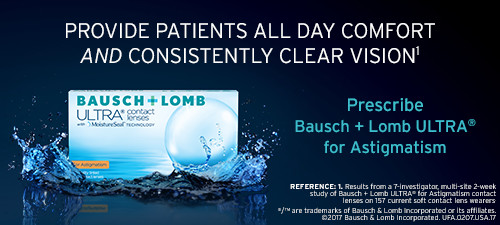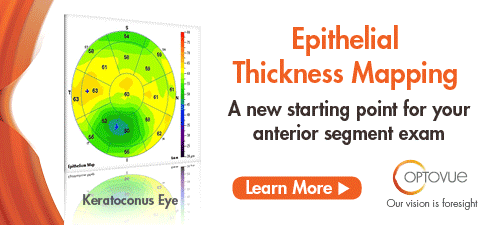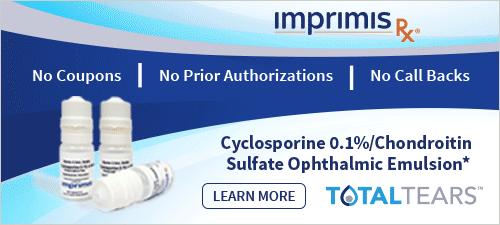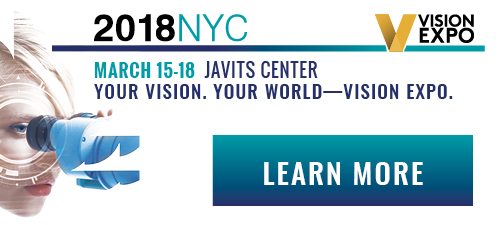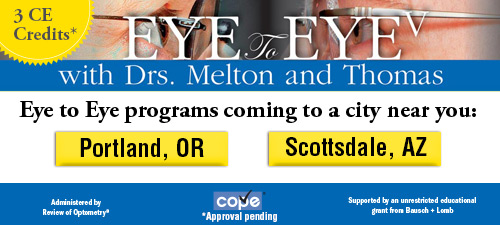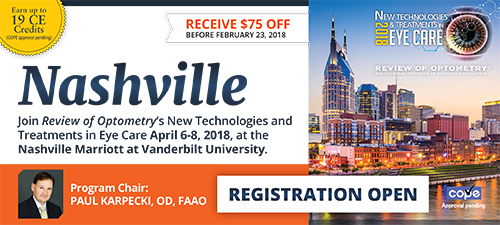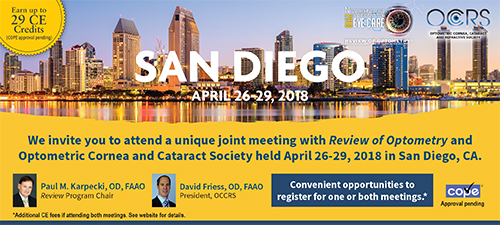
A
weekly e-journal by Art Epstein, OD, FAAO
Off the Cuff: Time and Outcome
With increasing government and insurer involvement in deciding what constitutes appropriate care, we may be nearing a nexus—or a collision—depending upon how you look at things. Understandably, insurers are focused on cost containment. To the provider, this equates to more patients being seen with less time to see each patient. In contrast, the government appears to be more focused on quality of care metrics and outcomes. However, the ever-changing acronyms and ever-increasing hoops to jump through seem to bear little relation to patient care or any meaningful improvement in how that care is delivered or received.
|
|||||
|
|||
| Application of 3D Printing Technology in RGPCL Simulation Fitting | ||||
Researchers wrote that the rigid gas permeable contact lens (RGPCL) is an ideal choice to improve the corrective vision of patients with a high degree of refractive error, keratoconus and corneal transplantation. However, they added that RGPCL fitting is not an easy task for those patients with extremely irregular corneal surface. Technicians or doctors often need to try many times to determine the relatively satisfied lens customization parameters. This repeated try-on process not only increases the discomfort of patients, but also increases the risks of corneal epithelial shedding or corneal infection. In order to conduct RGP fittings in a faster and safer manner, researchers undertook a new method of simulating RGPCL fittings in 3D printing technology. They wrote that the preliminary experimental results indicated that this method could effectively reduce the number of try-ons and increase patient satisfaction, while decreasing the risk of epithelial shedding or infection. |
||||
SOURCE: Zhao F, Zhao G, Weijie F, et al. Application of 3D printing technology in RGPCL simulation fitting. Med Hypotheses. 2018;113:74-76. |
||||
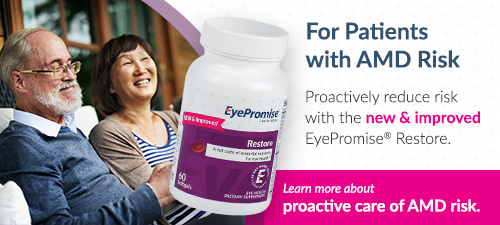
|
||
| Late-onset Descemet’s Membrane Detachment and Corneal Decompensation After Laser Peripheral Iridotomy: a Case Report | ||||
The incidence of cornea disorders after laser peripheral iridotomy is extremely low. However, corneal Descemet’s membrane detachment (DMD) combined with corneal decompensation after LPI could still occur.
A 69-year-old Chinese woman presented with persistent widespread corneal edema and inferior bullous lesions in her right eye for half a year. She had undergone LPI in both eyes 10 years ago for a prophylactic treatment. The patient received a detailed examination of vivo corneal confocal microscopy and swept-source optical coherence tomography (SS-OCT). It was a late-onset DMD that had a positional relationship with LPI, combined with corneal decompensation. Treatment was only supportive with artificial tears and soft contact lenses. This patient declined to accept keratoplasty because of financial difficulties. Researchers concluded that laser peripheral iridotomy might cause spontaneous, late-onset DMD and corneal decompensation. Ophthalmologists should be aware of this potential complication and proceed carefully. A careful examination of cornea especially around the LPI before keratoplasty seems to be necessary to circumvent other complications. |
||||
SOURCE: Fu Y, Zhou W, Li W, et al. Late-onset Descemet membrane detachment and corneal decompensation after laser peripheral iridotomy: A case report. Medicine (Baltimore). 2018;97(10):e0083. |
||||
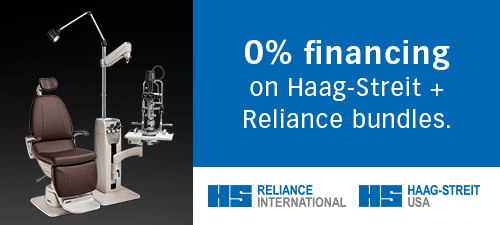
|
||
| The Effect of Orthokeratology on Axial Length Elongation in Children with Myopia: Contralateral Comparison Study | ||||
A retrospective review of medical records was performed on 45 monocular myopic subjects seven to 13 years of age who were treated with monocular orthokeratology (OK) lenses and followed-up for more than 12 months to evaluate the effectiveness of the OK lens slowing myopic progression compared with no intervention in pediatric eyes. The monocular myopia in the subjects' eyes was -0.75 to -4.25 D, and near emmetropia in the contralateral and with-the-rule astigmatism no greater than -1.50 D. Axial elongation OU, reflecting the progression of myopia was measured at baseline using the same AL-Scan Optical Biometer and compared between the two eyes of each individual every six months for one year in all subjects and for two years in nine subjects.
After 12 months of lens wear, axial length had increased by 0.36mm ± 0.23mm in the control eyes but showed far less change (+0.07mm ± 0.21mm) in the OK eyes. The nine subjects, followed-up for two years, showed no axial length change (+0.16mm ± 0.25mm) in the OK eyes after 24 months and significant axial length growth (+0.38mm ± 0.26mm) in the control eyes. Control eyes showed progressive axial length growth throughout the study compared with the one OK lens eye. Using a contralateral eye study design, which prevented the influence of potential confounding factors, effectiveness of the OK lens was demonstrated. Investigators found that myopic progression within a subject was excellent compared with no intervention. |
||||
SOURCE: Na M, Yoo A. The effect of orthokeratology on axial length elongation in children with myopia: Contralateral comparison study. Jpn J Ophthalmol. 2018; Mar 9. [Epub ahead of print]. |
||||
|
||||
| News & Notes | |||||||||||||||
| SECO Attendance Up SECO International, held in Atlanta between Feb. 28 and March 4, saw an increase in attendance of 5% year-over-year, as the event welcomed optometrists and ophthalmic professionals—including opticians, certified ophthalmic technicians and paraoptometric professionals—from 17 countries to learn about the latest research, innovations, treatment protocols and techniques in the profession. SECO 2019 will be moving to New Orleans (Feb. 20 to 24) and returning to Atlanta in 2020. This move marks the first time SECO has held a meeting outside of Atlanta since 1957.
|
|||||||||||||||
| B+L Agreement with Express Scripts Expands Coverage of Vyzulta Bausch + Lomb announced an agreement with Express Scripts to begin coverage of Vyzulta (latanoprostene bunod ophthalmic solution), 0.024%. Under the agreement, Vyzulta is covered under an access position on both the commercial Express Scripts National Preferred and Basic formularies, giving access to an additional 23 million people in the United States. The first prostaglandin analog with one of its metabolites being nitric oxide, Vyzulta is indicated for the reduction of intraocular pressure in individuals with open-angle glaucoma or ocular hypertension. Read more.
|
|||||||||||||||
| Total ECP Partners with Dr. Alan Glazier’s Shady Grove Eye & Vision Care Total Eye Care Partners entered into a joint venture partnership with Alan Glazier, OD, FAAO, and owner of Shady Grove Eye & Vision Care. Terms weren’t disclosed. Founded by Dr. Glazier more than 23 years ago, Shady Grove is a progressive, independent, medical-model optometric practice in the Washington, D.C. suburbs. In a press release, Bob Barton, president & CEO of Total ECP said, “We are beyond enthusiastic to have one of the most respected names in the optometric field join our family and we welcome his entire team.” In 2015, Dr. Glazier was selected by his peers as one of the 50 most influential optometrists nationwide, and in 2017, he was named Optometrist of the Year in the state of Maryland. Dr. Glazier, founder of ODs on Facebook and ODsOnFB.com, said in the release, “I’m excited for this next phase through affiliating with Total ECP. With their promise to maintain my practice legacy, Total ECP has created a new opportunity for optometrists looking for their next step. As an OD with a mature practice, the opportunity to shape an organization offering the first ‘legacy’ exit is particularly compelling, one in which my practice branding and mission remain intact. I am especially attracted to their commitment to medical-model optometry as part of their growth strategy. I look forward to helping pioneer this new vertical in our industry.” Paul Karpecki, OD, FAAO, Total ECP medical director, said, “We are thrilled to have a practice of the level of Alan Glazier’s Shady Grove Eye & Vision Care and the impressive doctors of that group joining Total ECP.”
|
|||||||||||||||
| Research: Sustained Vision Improvement in AMD with Dietary Supplement A two-year clinical trial involving more than 100 people diagnosed with age-related macular degeneration showed vision improvement with the use of carotenoid dietary supplements. The results were published in the October 2017 issue of Investigative Ophthalmology & Visual Science. Though the individuals with the early stages of AMD would have been expected to experience a deterioration in vision over the two years of the trial, those receiving carotenoids showed a significant improvement across 24 out of 32 measures of vision. Participants received supplementary meso-zeaxanthin, zeaxanthin and lutein plus co-antioxidants (MacuHealthPLUS+) or supplementary zeaxanthin and lutein plus co-antioxidants (AREDS2). Of note, 34.8% of trial participants on the MacuHealthPLUS+ formulation had a clinically meaningful improvement in vision after 24 months compared with 19.6% of individuals on the AREDS2-like formulation. Read more. |
|||||||||||||||
| Metrovision Enters U.S. market with the MonCvONE Line of Perimeters Metrovision entered the U.S. market with the MonCvONE line of full-field perimeters. The MonCvONE Clinical Research perimeter offers the standard features of other perimeters along with others including computer-assisted Goldmann perimetry; the ability to measure at photopic, mesopic and scotopic levels; and offers pupillometry, dark adaptometry, infant perimetry and binocular synchronized video imaging. Ideal for glaucoma, retinal and neuro-ophthalmic and pediatric specialties, the MonCvONE SAP and the MonCvONE PRO are available for clinical practices. All three perimeters come with a two-year warranty. SRD Vision will be representing the Metrovision product line in the United States. Read more. |
|||||||||||||||
| Alcon Launches National Media Campaign, Online Tool During World Glaucoma Week In recognition of World Glaucoma Week, Alcon helped to educate people on the world’s leading cause of irreversible blindness, offering new tools to improve the lives of millions of individuals living with glaucoma. The educational efforts aim to bring attention to the importance of regular eye screenings, the pressures associated with daily management of glaucoma and the potential benefits of microinvasive glaucoma surgery options such as the Alcon CyPass Micro-Stent. |
|||||||||||||||
|
|||||||||||||||
|
|||||||||||||||
|
Optometric Physician™ (OP) newsletter is owned and published by Dr. Arthur Epstein. It is distributed by the Review Group, a Division of Jobson Medical Information LLC (JMI), 11 Campus Boulevard, Newtown Square, PA 19073. HOW TO ADVERTISE |



